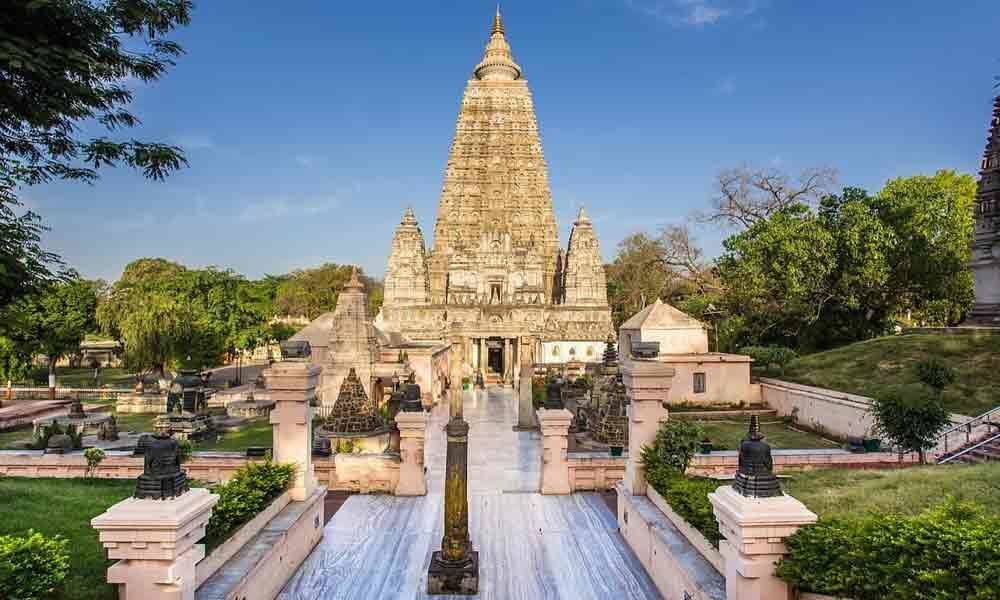Bodh Gaya: The land of Buddha
 Mahabodhi Temple
Mahabodhi Temple"Lumbini in Nepal, where the Buddha was born. Bodh Gaya is his place of enlightenment. Sarnath in Benares, the venue of his first sermon. And Kushinagar, where he attained 'mahaparinirvana' are the most important places on the Buddhist trail," explains our guide as he points out Buddhist pilgrims dressed in long flowing robes of different shades.
Tourists from all over Asia and Europe, throng the otherwise sleepy town of Bodh Gaya in Bihar, on the banks of the Niranjana River in large numbers almost waking it up from slumber. "All these hotels big and small, and the monasteries constructed by different countries, are filled to capacity in the winter months and right through the year with the numbers largely reduced during peak summer," he adds when asked about the astonishing number of hotels for a place so small.
Driving down from Patna we visit the 'Mangala Gouri', temple, one of the 12 shakti peeths and the 'Vishnupad temple' famous for obeisance to ancestors before reaching Bodh Gaya 10 kms away. Bodh Gaya is where we halt at the small but nicely built hotel the 'Royal Residency' with a restaurant named 'Amrapali' where we spot the odd Japanese, Burmese guests enjoying a meal.
We had already driven past some 10 grand monasteries on the way in the Thai, Japanese, Sinhalese and Burmese styles, where different Buddha statues were visible from the exterior. We were very clearly in the land of Buddha.
As we approached the Mahabodhi temple complex we saw a heavy posse of security outside protecting the monument declared a World Heritage Site. Like most religious places under threat by fundamentalist outfits, the 2,500-year-old Mahabodhi temple complex too had experienced low intensity bomb blasts some time ago and although there was no major damage, security has been beefed up since according to locals.
Wading past guides who flaunt their knowledge of different languages we reach the main entrance, which has an impressive carved stone railing wall. This beautiful structure is a replica of the original Sunga structures with elaborate sculptures and natural motifs and one can only marvel at the manner in which restoration work has been undertaken here.
Even before we are led to the famed 'Bodhi tree' under which Buddha is said to have attained enlightenment, we are informed about the seven different places within the complex where Buddha spent seven weeks meditating and experiencing the wisdom gleaned. We enter the pyramidal temple, which apparently dates back to the Gupta Kings.
According to UNESCO the present temple is one of the earliest and most imposing structures built entirely in brick from Gupta period (300- 600 CE). The temple's central tower is surrounded by four smaller towers and can be spotted from a distance. The upper portion of the temple is covered with gold given by the king of Thailand in 2013.
Inside the temple is an idol of Buddha and images of various Bodhisatvas. Our guide pointed out a small 'Shiva Linga' on the floor opposite the idol where devotees offered flowers and prayers and is just one of the many Hindu and Buddhist structures co-existing here. From the temple we moved towards the place of Buddha's enlightenment.
As we walked towards the Bodhi tree, the Peepal or fig tree associated with Buddha's enlightenment, we found ourselves in a long queue with young Bhikshus chanting 'Buddham Sharanam Gacchami' and the subsequent lines. Some distance away from the tree was a large canopy with a makeshift stage where a Buddhist chanting session was on.
Around the fenced tree and seated on the floor were several tourists their eyes closed in prayer. I was quite amused to see many folks sitting in meditation inside individual nets shaped like pyramids to ward off mosquitoes. On the stone platform surrounding the tree on all four sides were many visitors who sat under the widespread branches of the tree in silence assimilating the peace and positivity. There were others busy collecting heart shaped leaves falling to the ground as a gentle breeze wafted across.
Framing these leaves in wood and glass is business here for which there are many takers. The original tree having undergone both deliberate destruction and natural calamity, this tree is cited as the direct descendant of the original specimen where Gautama became Buddha after attaining perfect insight.
Emperor Ashoka is said to have built the Vajarasana or diamond throne at the foot of the Bodhi tree. Tourists have to peer through the high iron fencing around the tree seeing nothing other than its widespread branches and are content to merely sit under it for a while.
One of the interesting spots here is the Mucalinda lake, which has an idol of Buddha protected by a giant serpent hood at the centre. It is said that four weeks after the Buddha began meditating under the Bodhi tree, the heavens darkened and there was incessant rain for seven days.
Mucalinda, the mighty serpent King then rose from below the earth and protected Buddha from the raging storm with his hood as protective cover. Several stories from Buddha's life are depicted here and a recurring tale is that of Sujata. Of royal descent, the childless devotee of Buddha is said to have fed him kheer when she found him famished with hunger. Buddha blessed her and she experienced the joy of motherhood soon after. Sculpted on walls of the temple and many monasteries, Sujata also has a temple built for her in a village 10m kms away from Mahabodhi.
While Buddha is said to have spent one week under the Bodhi tree, the next six weeks in this place saw him mediate in different locations. We saw the spot marked by the Animesh Lochan stupa where Buddha stood unblinking looking at the Bodhi tree.
The areas where he walked back and forth between the stupa and the tree sprouted lotuses along the path and is named the 'ratnachakrama' or jewel park. As nightfall descends, the entire complex is lit up and tourists continue to stay under the tree of enlightenment finding peace within even as they collect heart-shaped leaves swept by the wind.















